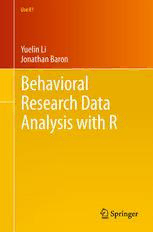Table Of ContentUse R!
SeriesEditors:
RobertGentleman KurtHornik GiovanniParmigiani
Forfurthervolumes:
http://www.springer.com/series/6991
Use R!
Albert:BayesianComputationwithR
Bivand/Pebesma/Go´mez-Rubio:AppliedSpatialDataAnalysiswithR
Cook/Swayne:InteractiveandDynamicGraphicsforDataAnalysis:
WithRandGGobi
Hahne/Huber/Gentleman/Falcon:BioconductorCaseStudies
Paradis:AnalysisofPhylogeneticsandEvolutionwithR
Pfaff:AnalysisofIntegratedandCointegratedTimeSerieswithR
Sarkar:Lattice:MultivariateDataVisualizationwithR
Spector:DataManipulationwithR
Yuelin Li • Jonathan Baron
Behavioral Research Data
Analysis with R
123
YuelinLi JonathanBaron
MemorialSloan-KetteringCancerCenter DepartmentofPsychology
DepartmentofPsychiatryandBehavioral UniversityofPennsylvania
Sciences 3720WalnutStreet
641LexingtonAve.7thFloor Philadelphia,Pennsylvania19104-6241
NewYork,NewYork10022-4503 USA
USA [email protected]
[email protected]
SeriesEditors:
RobertGentleman KurtHornik
PrograminComputationalBiology Departmentfu¨rStatistikundMathematik
DivisionofPublicHealthSciences Wirtschaftsuniversita¨tWienAugasse2-6
FredHutchinsonCancerResearchCenter A-1090Wien
1100FairviewAve.N,M2-B876 Austria
Seattle,Washington98109-1024
USA
GiovanniParmigiani
TheSidneyKimmelComprehensiveCancer
CenteratJohnsHopkinsUniversity
550NorthBroadway
Baltimore,MD21205-2011
USA
ISBN978-1-4614-1237-3 e-ISBN978-1-4614-1238-0
DOI10.1007/978-1-4614-1238-0
SpringerNewYorkDordrechtHeidelbergLondon
LibraryofCongressControlNumber:2011940221
©SpringerScience+BusinessMedia,LLC2012
Allrightsreserved.Thisworkmaynotbetranslatedorcopiedinwholeorinpartwithoutthewritten
permission of the publisher (Springer Science+Business Media, LLC, 233 Spring Street, New York,
NY10013, USA),except forbrief excerpts inconnection with reviews orscholarly analysis. Usein
connectionwithanyformofinformationstorageandretrieval,electronicadaptation,computersoftware,
orbysimilarordissimilarmethodologynowknownorhereafterdevelopedisforbidden.
Theuseinthispublicationoftradenames,trademarks,servicemarks,andsimilarterms,eveniftheyare
notidentifiedassuch,isnottobetakenasanexpressionofopinionastowhetherornottheyaresubject
toproprietaryrights.
Printedonacid-freepaper
SpringerispartofSpringerScience+BusinessMedia(www.springer.com)
Preface
ThisbookiswrittenforbehavioralscientistswhowanttoconsideraddingRtotheir
existingsetofstatisticaltools,orwanttoswitchtoRastheirmaincomputationtool.
We aimprimarilytohelppractionersofbehavioralresearchmakethetransitionto
R. The focus is to providepractical advice on some of the widely used statistical
methods in behavioral research, using a set of notes and annotated examples. We
alsoaimtohelpbeginnerslearnmoreaboutstatisticsandbehavioralresearch.These
arestatisticaltechniquesusedbypsychologistswhodoresearchonhumansubjects,
but of course they are also relevant to researchers in others fields that do similar
kindsofresearch.
WeassumethatthereaderhasreadtherelevantpartsofRmanualsontheCRAN
websiteathttp://www.r-project.org,suchas“AnIntroductiontoR”,“R
DataImport/Export”,and“RInstallationandAdministration”.Weassumethatthe
reader has gotten to the point of installing R and trying a couple of examples.
We also assume that the reader has relevant experiences in using other statistical
packagestocarryoutdataanalytictaskscoveredinthisbook.Thesourcecodeand
data for some of the examples in the book can be downloaded from the book’s
website at: http://idecide.mskcc.org/yl home/rbook/. We do not
dwellonthestatisticaltheoriesunlesssomedetailsareessentialintheappropriate
use of the statistical methods. When they are called for, theoretical details are
accompaniedbyvisualexplanationswheneverfeasible.Mathematicalequationsare
usedthroughoutthebookinthehopesthatreaderwillfindthemhelpfulingeneral,
and specifically in reaching beyond the scope of this book. For example, matrix
notationsareusedinthechapterscoveringlinearregressionandlinearmixed-effects
modelingbecausetheyarethestandardnotationsfoundinstatisticsjournals.Abasic
appreciationofmathematicalnotationsmayhelpthereadersimplementthesenew
techniquesbeforeapackagedsolutionisavailable.Nevertheless,themainemphasis
of this book is on the practical data analytic skills so that they can be quickly
incorporatedintothereader’sownresearch.
Thestatisticaltechniquesinthisbookrepresentmanyofstatisticaltechniquesin
ourownresearch.Thepedagogicalplanistopresentstraightforwardsolutionsand
add more sophisticated techniques if they help improve clarity and/or efficiency.
v
vi Preface
As can be seen in the first example in Chap. 1, the same analysis can be carried
outbyastraightforwardandamoresophisticatedmethod.Chapters1–4coverbasic
topicssuchasdataimport/export,statisticalmethodsforcomparingmeansandpro-
portions,andgraphics.Thesetopicsmaybepartofanintroductorytextforstudents
in behavioral sciences. Data analysis can often be adequately addressed with no
more than these straightforward methods. Chapter 4 contains plots in published
articles in the journal Judgment and Decision Making (http://journal.sjdm.org/).
Chapters5–7 covertopicswith intermediarydifficulty,such as repeated-measures
ANOVA,ordinaryleastsquareregression,logisticregression,andstatisticalpower
andsamplesizeconsiderations.Thesetopicsaretypicallytaughtatamoreadvanced
undergraduatelevelorfirstyeargraduatelevel.
Practitioners of behavioral statistics are often asked to estimate the statistical
power of a study design. R provides a set of flexible functions for sample size
estimation. More complex study designs may involve estimating statistical power
bysimulations.WefinditeasiertodosimulationswithRthanwithotherstatistical
packagesweknow.ExamplesareprovidedinChaps.7and11.
Theremainderofthisbookcovermoreadvancedtopics.Chapter8coversItem
ResponseTheory(IRT),astatisticalmethodusedinthedevelopmentandvalidation
of psychologicaland educationalassessment tools.We beginChap.8 with simple
examplesandendwithsophisticatedapplicationsthatrequireaBayesianapproach.
Suchtopicscaneasilytakeupafullvolume.Onlypracticalanalytictasksarecov-
eredsothatthereadercanquicklyadaptourexamplesforhisorherownresearch.
ThelatentregressionRaschmodelinSect.8.4.2highlightsthepowerandflexibility
of R in working with other statistical languages such as WinBUGS/OpenBUGS.
Chapter9coversmissingdataimputation.Chapters10–11coverhierarchicallinear
models applied in repeated-measured data and clustered data. These topics are
written for researchers already familiar with the theories. Again, these chapters
emphasizethepracticaldataanalysisskillsandnotthetheories.
R evolves continuously. New techniques and user-contributed packages are
constantly evolving. We strive to provide the latest techniques. However, readers
should consult other sources for a fuller understanding of relevant topics. The R
journalpublishesthelatesttechniquesandnewpackages.Anothergoodsourcefor
new techniquesis The Journalof Statistical Software (http://www.jstatsoft.org/).
The R-help mailing list is another indispensable resource. User contributions
make R a truly collaborative statistical computation framework.Many great texts
and tutorials for beginners and intermediate users are already widely available.
Beginner-level tutorials and how-to guides can be found online at the CRAN
“ContributedDocumentation”page.
Thisbookoriginatedfromouronlinetutorial“NotesontheuseofRforpsychol-
ogy experiments and questionnaires.” Many individuals facilitated the transition.
Wewouldliketothankthemformakingthisbookpossible.JohnKimmel,former
editorforthisbookatSpringer,firstencouragedustowritethisbookandprovided
continuousguidanceandencouragement.SpecialthanksgotoKathrynSchelland
Marc Strauss and other editorial staff at Springer on the preparation of the book.
Severalannonymousreviewersprovidedsuggestionsonhowtoimprovethebook.
Preface vii
Weareespeciallyindebtedtotheindividualswhohelpedsupplythedatausedinthe
examples,includingtheauthorsoftheRpackagesweuse,andthosewhomakethe
rawdatafreelyaccessibleonline.
NewYork YuelinLi
Philadelphia JonathanBaron
Contents
1 Introduction ............................................................... 1
1.1 AnExampleRSession .............................................. 1
1.2 AFewUsefulConceptsandCommands............................ 3
1.2.1 Concepts...................................................... 3
1.2.2 Commands.................................................... 4
1.3 DataObjectsandDataTypes........................................ 9
1.3.1 VectorsofCharacterStrings................................. 10
1.3.2 Matrices,Lists,andDataFrames............................ 12
1.4 FunctionsandDebugging ........................................... 15
2 ReadingandTransformingDataFormat .............................. 19
2.1 ReadingandTransformingData .................................... 19
2.1.1 DataLayout................................................... 19
2.1.2 ASimpleQuestionnaireExample........................... 19
2.1.3 OtherWaystoReadinData ................................. 25
2.1.4 OtherWaystoTransformVariables......................... 26
2.1.5 UsingRtoComputeCourseGrades ........................ 30
2.2 ReshapeandMergeDataFrames ................................... 31
2.3 DataManagementwithaSQLDatabase ........................... 33
2.4 SQLDatabaseConsiderations....................................... 35
3 StatisticsforComparingMeansandProportions..................... 39
3.1 ComparingMeansofContinuousVariables........................ 39
3.2 MoreonManualCheckingofData ................................. 42
3.3 ComparingSampleProportions..................................... 43
3.4 ModeratingEffectinloglin()................................... 45
3.5 AssessingChangeofCorrelatedProportions....................... 49
3.5.1 McNemarTestAcrossTwoSamples........................ 50
4 RGraphicsandTrellisPlots............................................. 55
4.1 DefaultBehaviorofBasicCommands.............................. 55
4.2 OtherGraphics....................................................... 56
ix
x Contents
4.3 SavingGraphics...................................................... 56
4.4 MultipleFiguresonOneScreen..................................... 57
4.5 OtherGraphicsTricks ............................................... 57
4.6 ExamplesofSimpleGraphsinPublications........................ 58
4.6.1 http://journal.sjdm.org/8827/
jdm8827.pdf.............................................. 60
4.6.2 http://journal.sjdm.org/8814/
jdm8814.pdf.............................................. 63
4.6.3 http://journal.sjdm.org/8801/
jdm8801.pdf.............................................. 64
4.6.4 http://journal.sjdm.org/8319/
jdm8319.pdf.............................................. 65
4.6.5 http://journal.sjdm.org/8221/
jdm8221.pdf.............................................. 66
4.6.6 http://journal.sjdm.org/8210/
jdm8210.pdf.............................................. 68
4.7 ShadedAreasUnderaCurve........................................ 69
4.7.1 Vectorsinpolygon() ..................................... 71
4.8 LatticeGraphics...................................................... 72
5 AnalysisofVariance:Repeated-Measures ............................. 79
5.1 Example1:TwoWithin-SubjectFactors ........................... 79
5.1.1 UnbalancedDesigns ......................................... 83
5.2 Example2:MaxwellandDelaney .................................. 85
5.3 Example3:MoreThanTwoWithin-SubjectFactors .............. 88
5.4 Example 4: A Simpler Design with Only One
Within-SubjectVariable ............................................. 89
5.5 Example5:OneBetween,TwoWithin ............................. 89
5.6 OtherUsefulFunctionsforANOVA................................ 91
5.7 GraphicswithErrorBars............................................ 93
5.8 AnotherWaytodoErrorBarsUsingplotCI()...................... 95
5.8.1 UseError()forRepeated-MeasureANOVA............ 96
5.8.2 Sphericity..................................................... 102
5.9 HowtoEstimatetheGreenhouse–GeisserEpsilon? ............... 103
5.9.1 Huynh–FeldtCorrection..................................... 105
6 LinearandLogisticRegression.......................................... 109
6.1 LinearRegression.................................................... 109
6.2 AnApplicationofLinearRegressiononDiamondPricing........ 110
6.2.1 PlottingDataBeforeModelFitting ......................... 111
6.2.2 CheckingModelDistributionalAssumptions............... 114
6.2.3 AssessingModelFit.......................................... 115
6.3 LogisticRegression.................................................. 118
6.4 Log–LinearModels.................................................. 119
6.5 RegressioninVector–MatrixNotation.............................. 120
6.6 CautiononModelOverfitandClassificationErrors ............... 122

